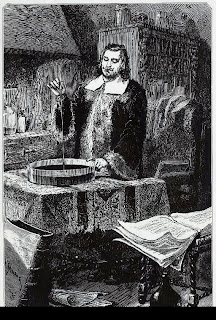GALILEO (1564 - 1642)
Galileo said that earth is not the centre of the universe, but like other planets it also revolves round the sun. But when in 1616, he proved for the first time that the sun was the centre of the universe and the earth revolves round the sun. He was summoned before the officials of the church and was ordered to stop his view. He didn’t give any public speech till 1630. Due to pressure he discarded his scientific beliefs. But he said in a broken voice; It is the earth which moves around the Sun. He was imprisoned where he became blind and died. This is the tragic story of Galileo.
Galileo was an Italian astronomer, physician and mathematician. He was born on February 15, 1564 in Pisa. He worked as a lecturer in mathematics in Pisa university. Once he read in a religious book that if two bodies of different weights are allowed to fall simultaneously from the same height the heavy body will hit the ground first. He proved this Aristotle’s statement wrong. To prove his theory he went upto the seventh floor of Pisa tower and dropped two metal balls weighing 100 pounds and 1 pound respectively. Many people were gathered to witness the experiment. The two balls hit the ground at the same time.
Galileo was instrumental earlier in the invention of a pendulum clock. The instrument was then called pulse meter. For this he relied on the principle that beat of the human pulse is fairly regular. It so happened that one day Galileo saw in the church a candelabra hung from the roof by a chain. When it was left it started swinging to and fro. Galileo after keen observation found that the time taken in each wing was the same. The timing he decided was with respect to the beat of the human pulse. His son Vinsenji made a wall clock on this basis later.
Galileo fabricated telescope and explored the universe. He saw the satellites of Jupiter and he proved that milky way is composed of millions of stars.
He published in 1638 his “Discourses and mathematical demonstrations relating to two new sciences”. In this work he disproved the assumption made in the Aristotlean physics. He had developed contacts with kepler. He also published “ A dialogue on the two principle systems of the world” a book in which he has explained the astronomical facts given by Copernicus and has said that Sun is static and is centre of the universe and the earth and other planets revolve round the Sun.
Galileo was an Italian astronomer, physician and mathematician. He was born on February 15, 1564 in Pisa. He worked as a lecturer in mathematics in Pisa university. Once he read in a religious book that if two bodies of different weights are allowed to fall simultaneously from the same height the heavy body will hit the ground first. He proved this Aristotle’s statement wrong. To prove his theory he went upto the seventh floor of Pisa tower and dropped two metal balls weighing 100 pounds and 1 pound respectively. Many people were gathered to witness the experiment. The two balls hit the ground at the same time.
Galileo was instrumental earlier in the invention of a pendulum clock. The instrument was then called pulse meter. For this he relied on the principle that beat of the human pulse is fairly regular. It so happened that one day Galileo saw in the church a candelabra hung from the roof by a chain. When it was left it started swinging to and fro. Galileo after keen observation found that the time taken in each wing was the same. The timing he decided was with respect to the beat of the human pulse. His son Vinsenji made a wall clock on this basis later.
Galileo fabricated telescope and explored the universe. He saw the satellites of Jupiter and he proved that milky way is composed of millions of stars.
He published in 1638 his “Discourses and mathematical demonstrations relating to two new sciences”. In this work he disproved the assumption made in the Aristotlean physics. He had developed contacts with kepler. He also published “ A dialogue on the two principle systems of the world” a book in which he has explained the astronomical facts given by Copernicus and has said that Sun is static and is centre of the universe and the earth and other planets revolve round the Sun.








